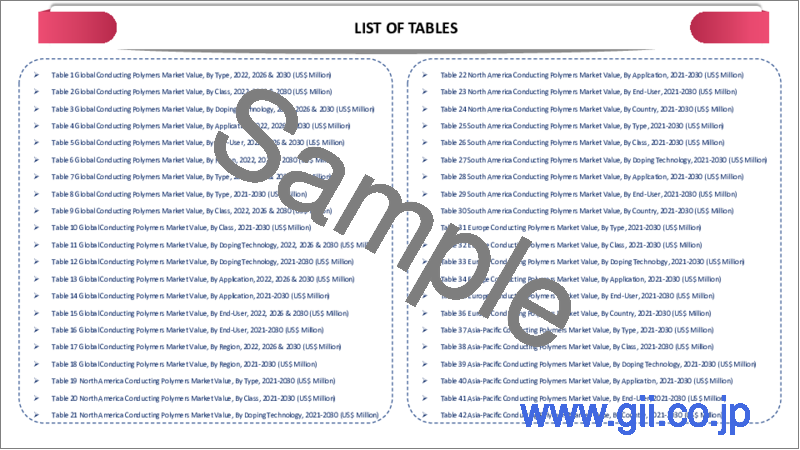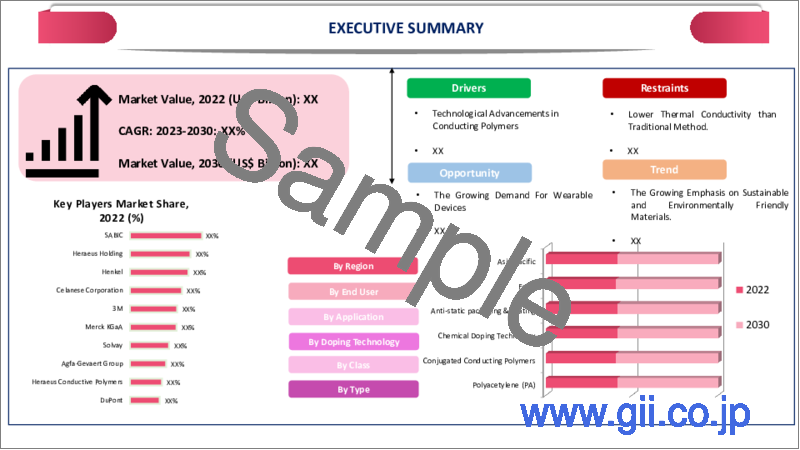|
|
市場調査レポート
商品コード
1336729
導電性ポリマーの世界市場-2023年~2030年Global Conducting Polymers Market - 2023-2030 |
||||||
|
● お客様のご希望に応じて、既存データの加工や未掲載情報(例:国別セグメント)の追加などの対応が可能です。 詳細はお問い合わせください。 |
|||||||
| 導電性ポリマーの世界市場-2023年~2030年 |
|
出版日: 2023年08月22日
発行: DataM Intelligence
ページ情報: 英文 195 Pages
納期: 約2営業日
|
- 全表示
- 概要
- 目次
市場概要
導電性ポリマーの世界市場は、2022年に35億2,000万米ドルに達し、2023~2030年の予測期間にCAGR 4.90%で成長し、2030年には51億4,000万米ドルに達すると予測されています。
発電、エネルギー貯蔵、センサー、腐食保護など様々な分野からの需要の増加が、導電性ポリマー市場の主な成長要因です。導電性ポリマーは、蓄電容量や充電システムの安定性を高め、エネルギー貯蔵システム全体の性能や効率を向上させることができるため、このエネルギー貯蔵分野における導電性ポリマーの成長に寄与しています。
アジア太平洋は、導電性ポリマー市場の成長地域のひとつです。中国、日本、インドなどの国々も、導電性ポリマーの生産と開発に同等の貢献をしています。例えば、2020年4月21日、マサチューセッツ工科大学(MIT)の研究者は、3Dプリンティングで使用される導電性ポリマー液体から、柔らかく柔軟な脳電極を開発しました。3Dプリントされたポリマーの使用により、より柔らかく、より安全で、より高速な金属ベースの電極が提供されます。
市場力学
導電性コーティングが自動車産業における導電性ポリマーの需要を押し上げる
ポリアニリンとポリピロールの導電性ポリマーは、自動車部品の導電性コーティングとして使用されています。ポリアニリンとポリピロールの導電性ポリマーコーティングは、従来の金属ベースのコーティングに比べて軽量であるという利点があります。その軽量性は、現代の自動車設計における全体的な軽量化努力の維持に役立ち、燃費の向上と排出ガスの低減に貢献します。
ポリアニリンやポリピロールなどの導電性ポリマーは、ユニークな機械的・電気的特性を備えており、幅広い自動車用途に適しています。これらのポリマーは、様々な自動車部品に腐食防止や静電気放散を提供する導電性コーティングを作成するために使用されます。導電性コーティングは、センサー、コネクター、電子モジュールなどの重要な部品に施され、信頼性の高い性能と長寿命を保証します。
導電性ポリマーのバイオメディカル市場
導電性ポリマーは、導電性ポリマーが使用される生体電極や人工筋肉などのバイオエレクトロニクスデバイスの開発において主要な役割を果たしています。これらのデバイスは生体システムとのインターフェースを持ち、信号伝達や作動を可能にします。導電性ポリマーの柔軟性と生体適合性は、心電図(ECG)や筋電図(EMG)モニタリング用の生体電極や、生体医療ロボット用のアクチュエーターなどの用途に適しています。
例えば、2023年6月28日、マサチューセッツ工科大学(MIT)の研究者は、導電性ポリマーを用いた金属を含まない電極を開発しました。この柔軟で堅牢な電極は、体内に安全に埋め込むことができるように設計されています。この電極は、長期間にわたって組織に損傷を与える可能性のある従来の方法に代わるものです。その柔軟な移植により、組織への影響はより少ないです。
環境への懸念
主な制限事項のひとつは、機械的ストレスや湿気、温度、紫外線などの環境要因にさらされた場合に劣化しやすいことです。このため、特定の用途における耐久性と長期安定性が制限されます。導電性ポリマーは湿度、酸素、光と接触すると劣化し、時間とともに導電性が失われます。
その毒性と生体適合性により、導電性ポリマーはバイオメディカル用途での成長が制限されています。導電性ポリマーの導電性は金属に比べて低いです。機械的強度が低く、温度が上昇すると安定性が低下します。生体適合性と物理的特性は、導電性ポリマーにおける主要な懸念事項です。
COVID-19影響分析
パンデミックの増加により、導電性ポリマーの需要が減少しています。多くの工場が操業を停止し、導電性ポリマーの需要が減少しました。パンデミック期間中、人々は旅行制限のため家に閉じこもり、自動車産業やエレクトロニクス産業に影響を与えました。このため、導電性ポリマーの成長は鈍化しました。
投資家が自動車産業への投資を控えたため、生産が不足し、導電性ポリマーのコストに影響を与えました。消費者の需要が変化し、導電性ポリマー市場の成長に大きな影響を与えました。パンデミック(世界的大流行)時には、政府も企業も公衆衛生に力を入れます。
ロシア・ウクライナ紛争の影響
ロシアとウクライナの紛争は、化学品などの原材料のサプライチェーン管理に影響を与えました。また、導電性ポリマー製品の輸出入ビジネスにも影響を与え、導電性ポリマーの成長に影響を与えました。このような原材料の不足は、価格の変動につながります。このような要因により、導電性ポリマー市場の成長が鈍化しました。
ロシア・ウクライナ戦争は多くの地域に影響を及ぼしています。この戦争のため、投資家はそうした地域での長期プロジェクトに投資していません。この地域で活動する産業は、消費者の需要を満たすために多くの困難に直面しています。戦争市場の地政学的問題により、導電性ポリマー材料の成長と生産は減速しています。
目次
第1章 調査手法と調査範囲
第2章 定義と概要
第3章 エグゼクティブサマリー
第4章 市場力学
- 影響要因
- 促進要因
- 導電性コーティングが自動車産業における導電性ポリマー需要を押し上げる
- 導電性ポリマーにおけるバイオメディカルが市場を押し上げる
- 抑制要因
- 環境への懸念
- 機会
- 影響分析
- 促進要因
第5章 産業分析
- ポーターのファイブフォース分析
- サプライチェーン分析
- 価格分析
- 規制分析
第6章 COVID-19分析
第7章 タイプ別
- 導電性ポリマー複合材料
- 固有導電性ポリマー
- 固有散逸性ポリマー
- 導電性プラスチック
- その他
第8章 クラス別
- 共役系導電性ポリマー
- 電荷移動ポリマー
- イオン伝導性ポリマー
- 導電性充填ポリマー
- その他
第9章 用途別
- 帯電防止包装・コーティング
- コンデンサー
- アクチュエーター・センサー
- 電池
- 太陽電池
- エレクトロルミネッセンス
- プリント基板
- その他
第10章 エンドユーザー別
- 食品
- 航空宇宙
- エレクトロニクス
- 自動車
- 産業用
- 医療
- その他
第11章 地域別
- 北米
- 米国
- カナダ
- メキシコ
- 欧州
- ドイツ
- 英国
- フランス
- イタリア
- ロシア
- その他欧州
- 南米
- ブラジル
- アルゼンチン
- その他南米
- アジア太平洋
- 中国
- インド
- 日本
- オーストラリア
- その他アジア太平洋
- 中東・アフリカ
第12章 競合情勢
- 競合シナリオ
- 市況/シェア分析
- M&A分析
第13章 企業プロファイル
- SABIC
- 会社概要
- 製品ポートフォリオと説明
- 財務概要
- 主な動向
- 3M
- Henkel
- Solvay
- Triton Systems
- AnCatt
- InGel Therapeutics
- AVH Polychem
- Soliyarn
- W7energy
第14章 付録
Market Overview
The Global Conducting Polymer Market reached US$ 3.52 billion in 2022 and is expected to reach US$ 5.14 billion by 2030 growing with a CAGR of 4.90% during the forecast period 2023-2030.
Increasing demand from various sectors such as power generation, energy storage, sensor, and corrosion protection is the major growth factor in the conducting polymer market. They can enhance the storage capacity and stability of charging systems, improving the overall performance and efficiency of energy storage systems, which contributes to the growth of conducting polymers in this energy storage sector.
Asia Pacific is among the growing region in the conducting polymer market. Countries such as China, Japan, and India also have equal contributions to the production and development of conducting polymers. For instance, on 21 Apr 2020, Researcher from MIT developed soft, flexible brain electrodes from conductive polymer liquid used in 3D printing. The usage of 3D-printed polymer provides softer, safer, and faster metal-based electrodes.
Market Dynamics
Conducting Coating Boosts Demand for Conducting Polymer in the Automotive Industry
Polyaniline and Polypyrrole conducting polymers are used as conductive coatings on automotive components. Polyaniline and Polypyrrole conducting polymer coatings offer the advantage of being lightweight compared to traditional metal-based coatings. Their lightweight nature helps in maintaining the overall weight reduction efforts in modern automotive design, contributing to improved fuel efficiency and lower emissions.
Conducting polymers, such as polyaniline and polypyrrole, offer unique mechanical and electrical properties which make them suitable for a wide range of automotive applications. These polymers are used to create conducting coatings that provide corrosion protection, and static dissipation on various automotive components. Conducting coatings can be applied to critical parts like sensors, connectors and electronic modules to ensure their reliable performance and longevity.
Biomedical in Conducting Polymer Boost Market
Conducting polymers plays a major role in the development of bioelectronic devices, such as bioelectrodes and artificial muscles in which conducting polymers are used. These devices can interface with biological systems, enabling signal transduction or actuation. Conducting polymer's flexibility and biocompatibility make them suitable for applications like bioelectrodes for electrocardiography (ECG) or electromyography (EMG) monitoring and actuators for biomedical robotics.
For instance, on 28 Jun 2023, Researcher from MIT developed a metal-free electrode using a conductive polymer. This flexible and robust electrode is designed for safe implantation within the body. It offers an alternative to traditional methods that may cause tissue damage over long time. Due to its flexible implantation which causes less effects on tissues.
Environmental Concerns
One of the key limitations is their vulnerability to degradation under mechanical stress or exposure to environmental factors like moisture, temperature, and UV radiation. This limits their durability and long-term stability in certain applications. Conducting polymer when in contact with humidity, oxygen, and light causes degradation and loss of conductivity over time.
Due to its toxicity and biocompatibility nature that restricts the growth of conducting polymer in biomedical applications. Conducting polymer conductivity is less compared with metals. It has less mechanical strength and is less stable when the temperature rises. Biocompatibility and physical property are major concerns in conducting polymer.
COVID-19 Impact Analysis
Due to rise in pandemic which results in a decrease the demand of conducting polymer. Many manufacturing of plants were on hold which cause decreased demand for conducting polymer. During covid people were isolated in their homes due to travel restrictions this impacted the automotive and electronics industry . Due to this factors there is downfall in the growth of conducting polymer.
Investors are not investing in the automotive industry, which causes shortage of production which impacted the cost of conducting polymer. Consumers shifted their demand that significantly impacted the growth conducting polymer market. During pandemic government and business focuses more on public health.
Russia-Ukraine War Impact
Russia-Ukraine conflicts, in which supply chain management of raw materials such as chemicals got affected. It also impacted the export and import business of conducting polymer products which affected the growth of conducting polymer. Shortage of these materials results in fluctuation of prices. Due to these factors, there is a downfall in the growth of the conducting polymer market.
The Russia-Ukraine war affects many regions. Due to this war, investors are not investing in long-term projects in such regions. Industry working in this region face many difficulties to fulfill the consumer demand. Due to the war market phases geopolitical issues slow downs the growth and production of the conducting polymer materials.
Segment Analysis
The global conducting polymer is segmented based on type, class, application, end-user, and region.
Enhancing Food Packaging And Processing With Conducting Polymers
Conducting polymers in the food packaging industry provides many additional facilities. For instance, they used to develop an intelligent packaging system that monitors the freshness and quality of food by detecting changes in temperature, gas composition, or pH. This advancement in technology helps to ensure food safety. Conducting polymers when applied in food processing operations it enhance the efficiency and quality of food by using an electrochemical process that removes pollutants from food.
For instance, on 3 April 2023, In an artificial biosystem conductive polymer was used to improve the efficiency of protein. The conductive polymer plays a role in facilitating the communication of electrons and chemicals between the different microbes in the system, thereby addressing the limitations of symbiotic relationships and enhancing overall production yields.
Geographical Penetration
Advancements in Conducting Polymer Technology
The Asia-Pacific conducting polymer market has witnessed continuous advancements in materials science and polymer technology. Research institutes, universities, and companies in countries like India, Japan, South Korea, and China are actively indulged in conducting polymer research and development. Governments in the region continuously promote research and development of advanced materials, including conducting polymers, through funding and policy incentives. This support encourages the growth of conducting polymer industries and facilitates their commercialization.
For instance, on 8 Mar 2023, a researcher at Berkely lab develop a conducting polymer covering for lithium-ion batteries. The covering polymer is named as HOS-PFM which provides power to batteries. This HOS-PFM has both electrons and ions that ensure stability and charging/discharging rate
Competitive Landscape
The major global players in the market include: SABIC, 3M, Henkel, Solvay Triton Systems, AnCatt, InGel Therapeutics, AVH Polychem, Soliyarn, W7energy.
Why Purchase the Report?
- To visualize the global conducting polymer market segmented based on type, class, application, end-user, and region, as well as understand key commercial assets and players.
- Identify commercial opportunities by analyzing trends and co-development.
- Excel data sheet with numerous data points of conducting polymer market-level with all segments.
- PDF report consists of a comprehensive analysis after exhaustive qualitative interviews and an in-depth study.
- Product mapping available as excel consisting of key product of all the major players.
The global conducting polymer market report would provide approximately 69 tables, 80 figures, and 195 Pages.
Target Audience 2023
- Manufacturers/ Buyers
- Industry Investors/Investment Bankers
- Research Professionals
- Emerging Companies
Table of Contents
1. Methodology and Scope
- 1.1. Research Methodology
- 1.2. Research Objective and Scope of the Report
2. Definition and Overview
3. Executive Summary
- 3.1. Snippet By Type
- 3.2. Snippet By Class
- 3.3. Snippet By Application
- 3.4. Snippet By End-User
- 3.5. Snippet by Region
4. Dynamics
- 4.1. Impacting Factors
- 4.1.1. Drivers
- 4.1.1.1. Conducting Coating Boost Demand for Conducting Polymer in the Automotive Industry
- 4.1.1.2. Biomedical in Conducting Polymer Boost Market
- 4.1.2. Restraints
- 4.1.2.1. Environmental Concerns
- 4.1.3. Opportunity
- 4.1.4. Impact Analysis
- 4.1.1. Drivers
5. Industry Analysis
- 5.1. Porter's Five Force Analysis
- 5.2. Supply Chain Analysis
- 5.3. Pricing Analysis
- 5.4. Regulatory Analysis
6. COVID-19 Analysis
- 6.1. Analysis of COVID-19
- 6.1.1. Scenario Before COVID
- 6.1.2. Scenario During COVID
- 6.1.3. Scenario Post COVID
- 6.2. Pricing Dynamics Amid COVID-19
- 6.3. Demand-Supply Spectrum
- 6.4. Government Initiatives Related to the Market During Pandemic
- 6.5. Manufacturers' Strategic Initiatives
- 6.6. Conclusion
7. By Type
- 7.1. Introduction
- 7.1.1. Market Size Analysis and Y-o-Y Growth Analysis (%), By Type
- 7.1.2. Market Attractiveness Index, By Type
- 7.2. Conducting Polymer Composites*
- 7.2.1. Introduction
- 7.2.2. Market Size Analysis and Y-o-Y Growth Analysis (%)
- 7.3. Inherently Conductive Polymers
- 7.4. Inherently Dissipative Polymers
- 7.5. Conductive Plastics
- 7.6. Others
8. By Class
- 8.1. Introduction
- 8.1.1. Market Size Analysis and Y-o-Y Growth Analysis (%), By Class
- 8.1.2. Market Attractiveness Index, By Class
- 8.2. Conjugated Conducting Polymer*
- 8.2.1. Introduction
- 8.2.2. Market Size Analysis and Y-o-Y Growth Analysis (%)
- 8.3. Charge Transfer Polymers
- 8.4. Ionically Conducting Polymers
- 8.5. Conductively Filled Polymers
- 8.6. Others
9. By Application
- 9.1. Introduction
- 9.1.1. Market Size Analysis and Y-o-Y Growth Analysis (%), By Application
- 9.1.2. Market Attractiveness Index, By Application
- 9.2. Anti-static packaging & coating*
- 9.2.1. Introduction
- 9.2.2. Market Size Analysis and Y-o-Y Growth Analysis (%)
- 9.3. Capacitors
- 9.4. Actuators & Sensors
- 9.5. Batteries
- 9.6. Solar Cells
- 9.7. Electroluminescence
- 9.8. Printed Circuit Board
- 9.9. Others
10. By End-User
- 10.1. Introduction
- 10.1.1. Market Size Analysis and Y-o-Y Growth Analysis (%), By End-User
- 10.1.2. Market Attractiveness Index, By End-User
- 10.2. Food *
- 10.2.1. Introduction
- 10.2.2. Market Size Analysis and Y-o-Y Growth Analysis (%)
- 10.3. Aerospace
- 10.4. Electronics
- 10.5. Automotive
- 10.6. Industrial
- 10.7. Healthcare
- 10.8. Others
11. By Region
- 11.1. Introduction
- 11.1.1. Market Size Analysis and Y-o-Y Growth Analysis (%), By Region
- 11.1.2. Market Attractiveness Index, By Region
- 11.2. North America
- 11.2.1. Introduction
- 11.2.2. Key Region-Specific Dynamics
- 11.2.3. Market Size Analysis and Y-o-Y Growth Analysis (%), By Type
- 11.2.4. Market Size Analysis and Y-o-Y Growth Analysis (%), By Class
- 11.2.5. Market Size Analysis and Y-o-Y Growth Analysis (%), By Application
- 11.2.6. Market Size Analysis and Y-o-Y Growth Analysis (%), By End-User
- 11.2.7. Market Size Analysis and Y-o-Y Growth Analysis (%), By Country
- 11.2.7.1. U.S.
- 11.2.7.2. Canada
- 11.2.7.3. Mexico
- 11.3. Europe
- 11.3.1. Introduction
- 11.3.2. Key Region-Specific Dynamics
- 11.3.3. Market Size Analysis and Y-o-Y Growth Analysis (%), By Type
- 11.3.4. Market Size Analysis and Y-o-Y Growth Analysis (%), By Class
- 11.3.5. Market Size Analysis and Y-o-Y Growth Analysis (%), By Application
- 11.3.6. Market Size Analysis and Y-o-Y Growth Analysis (%), By End-User
- 11.3.7. Market Size Analysis and Y-o-Y Growth Analysis (%), By Country
- 11.3.7.1. Germany
- 11.3.7.2. UK
- 11.3.7.3. France
- 11.3.7.4. Italy
- 11.3.7.5. Russia
- 11.3.7.6. Rest of Europe
- 11.4. South America
- 11.4.1. Introduction
- 11.4.2. Key Region-Specific Dynamics
- 11.4.3. Market Size Analysis and Y-o-Y Growth Analysis (%), By Type
- 11.4.4. Market Size Analysis and Y-o-Y Growth Analysis (%), By Class
- 11.4.5. Market Size Analysis and Y-o-Y Growth Analysis (%), By Application
- 11.4.6. Market Size Analysis and Y-o-Y Growth Analysis (%), By End-User
- 11.4.7. Market Size Analysis and Y-o-Y Growth Analysis (%), By Country
- 11.4.7.1. Brazil
- 11.4.7.2. Argentina
- 11.4.7.3. Rest of South America
- 11.5. Asia-Pacific
- 11.5.1. Introduction
- 11.5.2. Key Region-Specific Dynamics
- 11.5.3. Market Size Analysis and Y-o-Y Growth Analysis (%), By Type
- 11.5.4. Market Size Analysis and Y-o-Y Growth Analysis (%), By Class
- 11.5.5. Market Size Analysis and Y-o-Y Growth Analysis (%), By Application
- 11.5.6. Market Size Analysis and Y-o-Y Growth Analysis (%), By End-User
- 11.5.7. Market Size Analysis and Y-o-Y Growth Analysis (%), By Country
- 11.5.7.1. China
- 11.5.7.2. India
- 11.5.7.3. Japan
- 11.5.7.4. Australia
- 11.5.7.5. Rest of Asia-Pacific
- 11.6. Middle East and Africa
- 11.6.1. Introduction
- 11.6.2. Key Region-Specific Dynamics
- 11.6.3. Market Size Analysis and Y-o-Y Growth Analysis (%), By Type
- 11.6.4. Market Size Analysis and Y-o-Y Growth Analysis (%), By Class
- 11.6.5. Market Size Analysis and Y-o-Y Growth Analysis (%), By Application
- 11.6.6. Market Size Analysis and Y-o-Y Growth Analysis (%), By End-User
12. Competitive Landscape
- 12.1. Competitive Scenario
- 12.2. Market Positioning/Share Analysis
- 12.3. Mergers and Acquisitions Analysis
13. Company Profiles
- 13.1. SABIC *
- 13.1.1. Company Overview
- 13.1.2. Product Portfolio and Description
- 13.1.3. Financial Overview
- 13.1.4. Key Developments
- 13.2. 3M
- 13.3. Henkel
- 13.4. Solvay
- 13.5. Triton Systems
- 13.6. AnCatt
- 13.7. InGel Therapeutics
- 13.8. AVH Polychem
- 13.9. Soliyarn
- 13.10. W7energy
LIST NOT EXHAUSTIVE
14. Appendix
- 14.1. About Us and Services
- 14.2. Contact Us




